Steven Edney and Louise Dowle’s middle-sized tropical garden, Sweetbriar, is just three years old. But it’s already opening for the NGS today (6th August).
Both Steven and Louise are professional gardeners. Steven runs the beautiful Salutation garden in Sandwich, and Louise gardens for private clients. Their own garden is very much a joint venture, they say, although both acknowledge that it’s a little more ‘Louise’s garden’ than it is Steven’s.
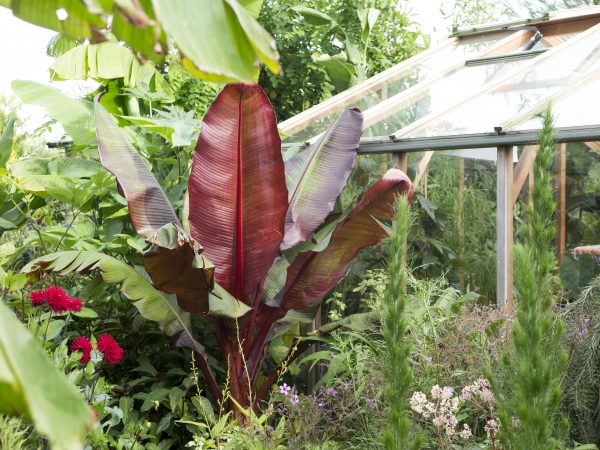
Banana palm, Eupatorium capillifolium, and dahlias crowd round the greenhouse, which is in the centre of the garden.
They decided to have an tropical garden because they wanted to try something different from their normal daily gardening.
And Steven adds that, although a tropical garden needs a lot of work in spring and autumn, it is very easy to look after in summer.
In a traditional English garden, summer means mowing lawns, dead-heading flowers, clipping hedges and weeding. None of which apply in a tropical garden, where every inch of soil is carpeted with lush vegetation. So as professional gardeners, they can (almost) relax when they get home to their own garden.
With a greenhouse at its heart
Many tropical plants need to over-winter, so you definitely need a greenhouse. Steven and Louise’s greenhouse is in the middle of their garden, just a few feet away from the back door and windows.
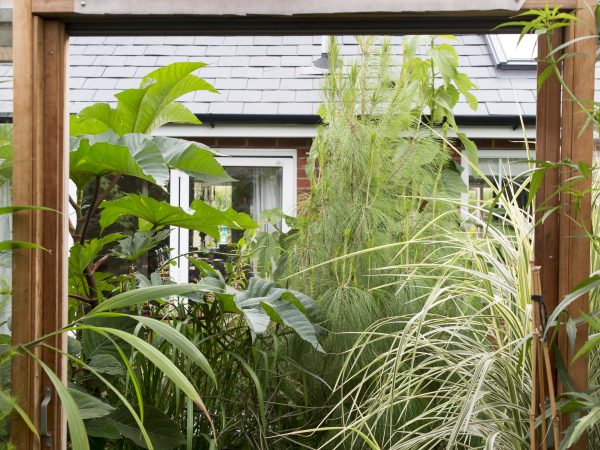
The view from the greenhouse door – the back of the house is just a few feet away, but you can barely see it.
Once you’re in the greenhouse, though, you could be a world away from rural Kent. Steven and Louise use it to house tender plants in the winter. In the summer, it’s a pretty conservatory – the perfect place to sit and relax with a drink after work.
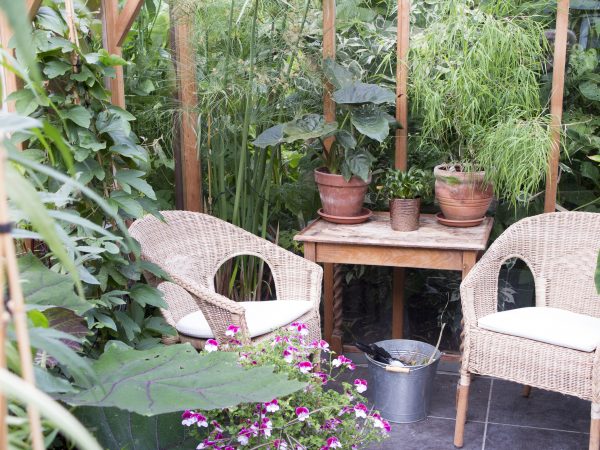
Full of plants in the winter. A relaxing place to be in the summer.
Add a winding mulch path…
A mulch path winds round the garden, starting with steps from a small terrace outside the back door. It meanders around trees and plants, ending up in an archway down to the terrace again.
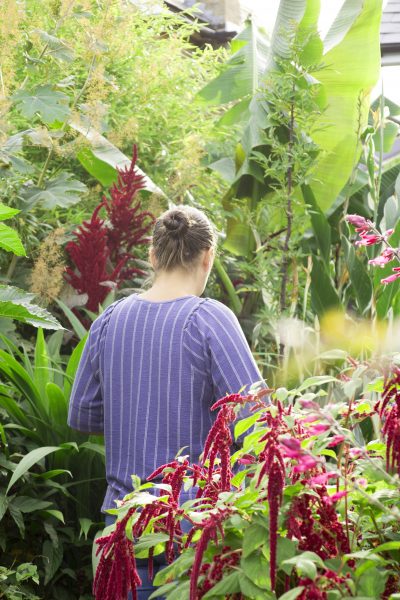
As you walk along the winding path, a riot of different leaf shapes and textures brush against you. The dramatically trailing red tassels are amaranth (Amaranthus caudatus).
Instead of a lawn, there are plants everywhere. Although the garden is probably no more than a quarter of an acre, Steven and Louise are potentially curating two National Collections – one of Pseudopanax, the other of Persicaria virginiana species and cultivars.
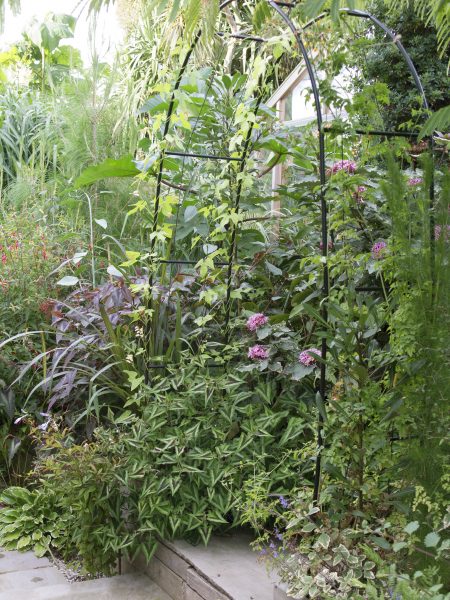
The path steps back down to the terrace again, through an archway.
A tropical garden is foliage-based…
One of the things Steven most loves about their tropical garden is that it is centred around different foliage shapes, colours and textures. ‘I’ve always wanted to do a ‘green’ garden,’ he says. ‘There are flowers, but they’re a bonus – almost a surprise.’
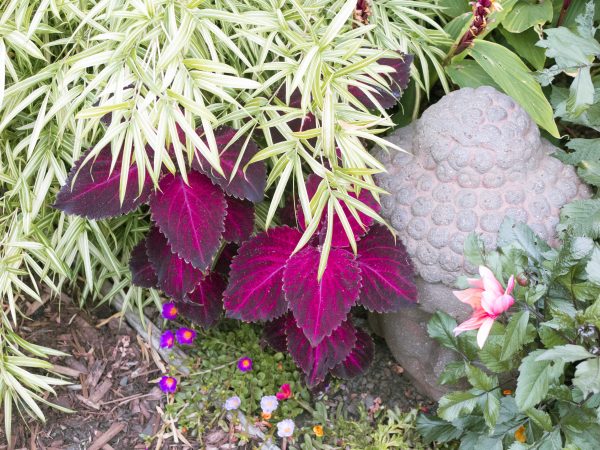
The contrasting leaves of coleus and bamboo.

One of the many striking and unusual plants in the garden. Its drama comes from its sculptural shape, not the colour of its flowers.
Use commonly-found flowers for a tropical effect…
The explorers of the Georgian and Victorian times brought many exotic plants to Britain. Dahlias originally came from Mexico as a food like a potato. Since then, they’ve become a staple of a traditional British garden, and are now experiencing quite a revival.
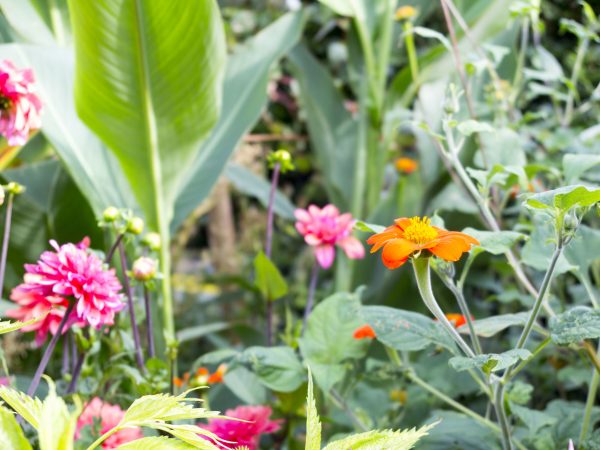
Shots of hot pink and orange from dahlias and tithonia amongst Steven and Louise’s verdant greenery.
Amaranthus, too, is largely seen as a traditional bedding plant in Britain, and now considered somewhat old-fashioned. But it ,too, originally came from Mexico. Its seeds can be used like quinoa and its leaves used in salads. And in the flower border, it strikes a flamboyant tropical note.
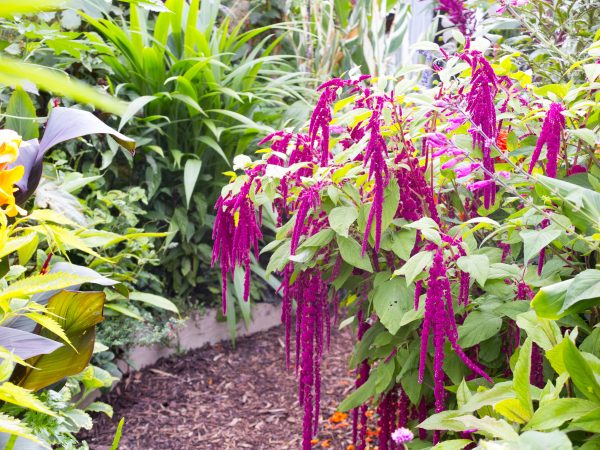
Amaranthus caudatus is very easy to grow – this patch self-seeded itself in Steven and Lou’s garden.
Cannas, on the other hand, have always been enjoyed as tropical plants, for their brilliant flowers and sculptural leaves. An increasing number of cultivars are now more hardy, so these stunning plants can generally be grown in Britain.

A truly tropical look. A solo canna trumpets its gloriousness in a forest of greenery.

And I love this canna, with its yellow-striped leaves.
An tropical garden is very private…
Steven and Louise’s house is detached, but there are houses close by on either side. Towering foliage, bamboos and the sheer density of the planting means that the garden is very private. At the back, there is a deck, a ‘family room’ shed and a hot tub, all tucked away behind the lavish greenery.
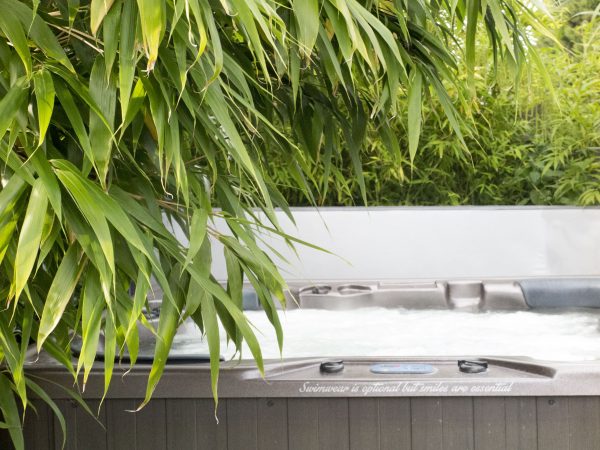
The hot tub is at the back of the garden, surrounded by bamboo. and other tall plants.
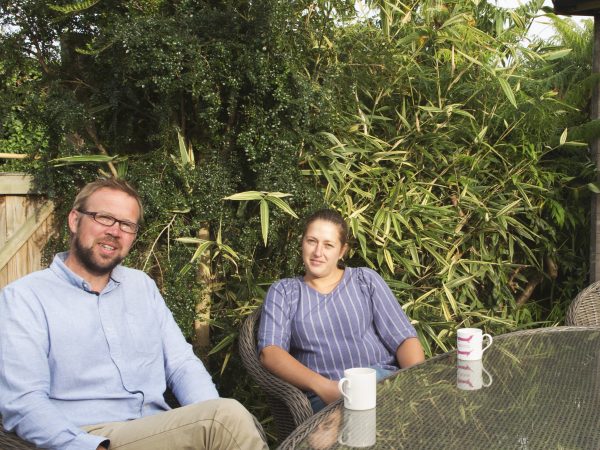
Steven and Louise enjoying a tea on the deck in the last of the evening sun, shielded by abundant planting.
There are more tips on how to create an exotic garden here.
You can visit Sweetbriar today, on Sunday 10th September and Sunday 8th October, when it’s open for the NGS. And once you’ve got the bug for exotic gardens, Steven has also been extending the tropical garden at The Salutation (which is close by).
And do please spread the ‘exotic’ garden word, using the buttons below. Thank you!
The post An unusual tropical garden in the Kent countryside appeared first on The Middle-Sized Garden.
from The Middle-Sized Garden http://www.themiddlesizedgarden.co.uk/an-unusual-tropical-garden-in-the-kent-countryside/
No comments:
Post a Comment